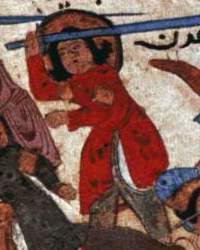
"Turkic boot straps and attached garters" Topic
2 Posts
All members in good standing are free to post here. Opinions expressed here are solely those of the posters, and have not been cleared with nor are they endorsed by The Miniatures Page.
For more information, see the TMP FAQ.
Back to the Medieval Media Message Board Back to the Classical Asian Warfare Message Board Back to the Ancients Discussion Message Board Back to the Medieval Discussion Message Board
Areas of InterestAncients
Medieval
Renaissance
Featured Hobby News Article
Featured Link
Top-Rated Ruleset
Featured Showcase Article The next Teutonic Knights unit - Crossbowmen!
Featured Profile Article For the time being, the last in our series of articles on the gates of Old Jerusalem.
Featured Book Review
Featured Movie Review
|
| Druzhina | 08 Nov 2014 4:29 a.m. PST |
Adapted from CLOTHING The Saljuqs and the post-Saljuq period by Elsie H. Peck
'A characteristic fashion for rulers and men of high rank in the late 12th and early 13th centuries was tall boots, a natural choice of footgear for nomadic peoples, with a long tradition in Persia, from the Achaemenid period onward. On two ceramic pieces the pointed boot tops are elongated to form straps, which were apparently attached to inner belts in the manner of the leggings worn by the Parthians and Sasanians. That the boots illustrated in the Varqa wa Golāh manuscript were attached in this way is clear from battle scenes, in which the displacement of the coat reveals a broad thong reaching from the knee to an inner belt. This method of securing boots was certainly of Central Asian origin and is represented in 6th-7th-century sculptures from Fondukistan, and 8th-9th-century wall paintings from Bäzäklik.'

The illustrations referenced are:
Parthian Ceramics
Parthian horse-archer plaque, Syria, 1st Century BC-3rd Century AD, British Museum
Parthian terracotta relief of a rider, Musée du Louvre
Varqa wa Golāh
4: Scene of war; inscription:
9: War Scene containing four riders and four people including two dead and fallen to the ground.
23: Gulshâh kills Rabî by driving the lance in his chest; four horsemen and Warqah bound; inscription:
26: Gulshâh struggles with Ghâlib, on foot; on one side Gulshâh's horse, throat cut, and on the other, that of Ghâlib, two legs cut off; in corners, weapons
41: Scene of war; Warqah brings defeat to the army of Bahrain and Adan and the pursuit.
Pranidhi scene No. 6, Temple No. 9, Bäzäklik, near Turfan, Tarim Basin, Central Asia
Royal Couple, Fondukistan, late 7th-early 8th century The boot-straps at Fondukistan may also have a garter' attached. Something similar can be seen on A Kipchak Balbal at Luhansk, 11th century & A Kipchak Balbal, 12th century, Hermitage Museum, St. Petersburg, Russia Druzhina
Illustrations of Costume & Soldiers |
| GurKhan | 08 Nov 2014 7:42 a.m. PST |
I am not sure that there are in fact boot-straps or legging-straps on that first Parthian terracotta, the BM one. What is visible on the thigh is surely a "Sarmatian-style" dagger in a four-lobed sheath see Winkelmann at link abb. VI-VIII. |
|

